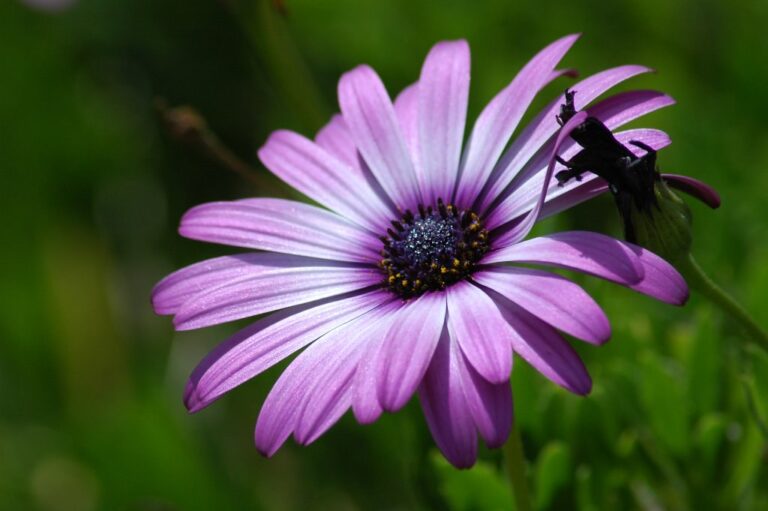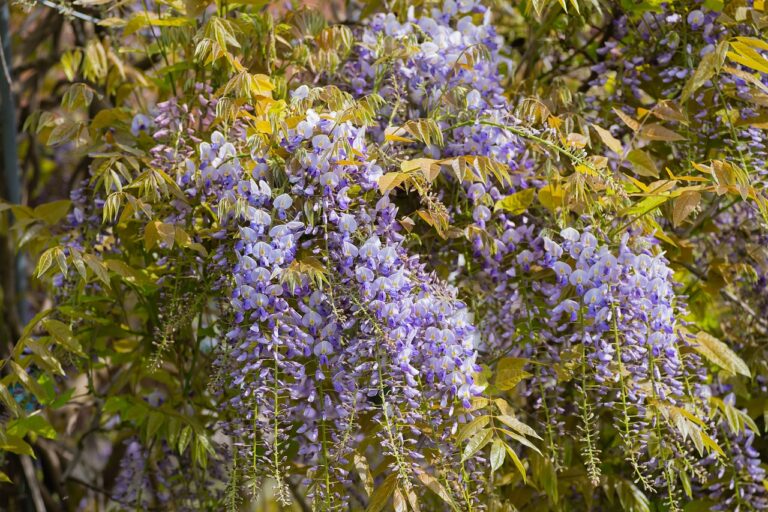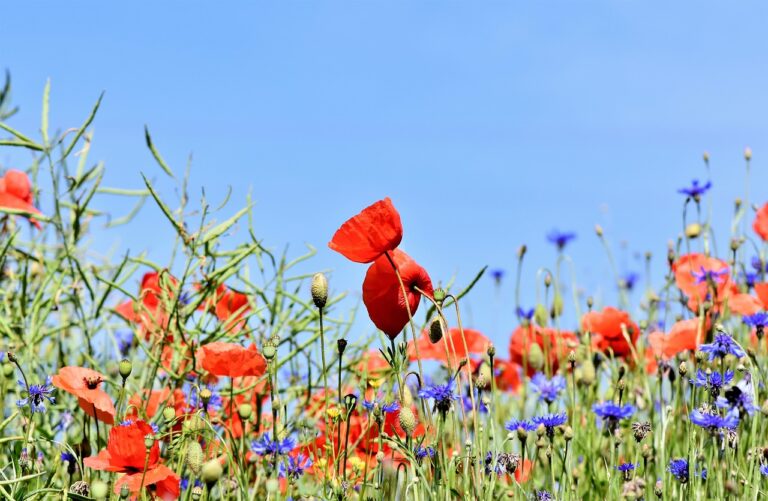Exploring the Benefits and Uses of Lavender and Marigolds
Exploring the Benefits and Uses of Lavender and Marigolds showcases their therapeutic, stress-reducing, and anti-inflammatory properties. Lavender aids digestion and promotes relaxation, while marigolds benefit skin health and possess calming effects. They reduce stress and inflammation, enhancing overall well-being. These plants are valuable tools for stress management and well-rounded garden ecosystems. Lavender’s antibacterial qualities and marigolds’ skin healing effects make them essential additions. Consider companion planting to maximize their benefits in vibrant, biodiverse gardens. Further insights await for those seeking to reveal the full potential of lavender and marigolds in various applications.
Lavenders Therapeutic Properties
Lavender, with its essential herb properties, offers a range of therapeutic benefits including supporting healthy digestion and acting as a gentle nervine sedative for the nervous system. This versatile herb, known scientifically as Lavandula angustifolia, has been historically utilized for its anti-bacterial and anti-fungal properties, making it a valuable resource in treating various ailments. Its ability to address digestive issues, headaches, grief, and stress showcases its wide-ranging applications.
When it comes to mental health, lavender shines as a natural remedy for anxiety and stress. Its calming effects on the nervous system can help alleviate symptoms of anxiety and promote relaxation. The carminative, sedative, bitter, and antimicrobial actions of lavender make it a go-to herb for individuals looking to manage stress and find relief from the pressures of daily life.
Moreover, lavender’s topical uses should not be overlooked. From sitz baths for healing to treating vaginal infections, lavender’s therapeutic properties extend beyond internal health. Its anti-bacterial and anti-fungal properties play an important role in promoting skin health and overall well-being. By incorporating lavender into various forms of self-care routines, individuals can harness the full potential of this remarkable herb for both physical and mental wellness.
Marigolds in Skincare
Marigolds offer a wide range of benefits for healthy skin. The anti-inflammatory properties found in marigolds make them excellent for soothing skin irritations. Marigold extracts are often included in skincare products for their healing and calming effects on the skin, making them a great addition to any skincare routine.
Marigolds for Healthy Skin
With their powerful antioxidant properties, marigolds offer a natural solution for nourishing and safeguarding the skin against free radical damage. Marigolds, when included in skincare products alongside lavender essential oil, deliver a variety of skin benefits. Their anti-inflammatory properties help calm irritated skin, while their antiseptic qualities purify the skin and prevent infections. The high flavonoid content in marigolds contributes to improving skin tone and reducing blemishes, resulting in healthy and radiant skin. Using marigold-infused skincare products can lead to overall improved skin health, making them a valuable addition to any skincare routine.
Marigold Extracts Benefits
Extracts derived from marigolds have been scientifically proven to provide a multitude of benefits for skin health when incorporated into skincare products. Marigold extracts are rich in antioxidants, vitamins, and minerals that support skin health. Their anti-inflammatory properties can help soothe irritated skin and reduce redness effectively. Additionally, marigolds, particularly calendula, are commonly used in skincare products for their healing and moisturizing effects. These extracts aid in wound healing, reducing scarring, and promoting overall skin regeneration. Due to their antibacterial properties, marigolds in skincare formulations can assist in combating acne, eczema, and various other skin conditions. When combined with ingredients like lavender essential oil, marigold extracts create potent skincare products that promote healthy and radiant skin.
Marigold-Infused Skincare Products
Incorporating marigold-infused skincare products into your daily routine can provide a natural solution for soothing and protecting your skin. Marigolds offer a range of benefits when used in skincare products:
- Anti-Inflammatory Properties: Marigold extracts help soothe and calm the skin, making them ideal for sensitive or irritated skin.
- Antioxidant Rich: The antioxidants present in marigold-infused products aid in protecting the skin from environmental damage, promoting a healthier complexion.
- Wound Healing Abilities: Marigolds can assist in wound healing and skin regeneration, making them beneficial for addressing skin issues like acne and promoting overall skin health.
Stress Reduction Benefits
As we investigate the stress reduction benefits of lavender and marigolds, it’s crucial to understand the calming properties of lavender and the soothing effects of marigolds. Lavender’s capacity to decrease anxiety levels and encourage relaxation, along with marigolds’ calming impact, make them valuable tools for stress management. Integrating these botanicals into your daily routine can help decrease cortisol levels, alleviate stress, and enhance overall well-being.
Calming Properties of Lavender
With its well-known reputation for inducing relaxation and reducing stress, lavender is a popular choice in aromatherapy for its calming properties. Regarding stress reduction benefits, lavender essential oil stands out for its ability to reduce anxiety and promote a sense of calmness. Here are three key ways lavender helps in calming properties:
- Aromatherapy: Inhaling the scent of lavender can help relax the mind and body, aiding in stress relief.
- Sedative Properties: Lavender’s sedative properties make it effective in promoting relaxation and improving sleep quality.
- Cortisol Regulation: Research suggests that lavender may help lower cortisol levels, the stress hormone, further supporting its calming benefits.
Soothing Effects of Marigolds
Marigolds offer a natural solution for reducing stress by harnessing their soothing effects on the nervous system. These flowers contain compounds that act on neurotransmitters, promoting relaxation and easing tension. The vibrant colors and pleasant fragrance of marigolds contribute to creating a calming atmosphere, aiding in stress reduction. In aromatherapy, marigold extracts are utilized to alleviate anxiety and tension, enriching overall well-being. Whether present in gardens or indoor spaces, the mere presence of marigolds can help boost mood and reduce feelings of stress. Incorporating marigolds into daily environments provides a natural way to improve mental health, offering a sense of tranquility through their interaction with the nervous system.
Anti-Inflammatory Properties
Exploring the anti-inflammatory properties of lavender and marigolds reveals their potent effects in reducing inflammation both internally and externally through their unique compounds and constituents. Lavender, known for its calming scent, contains powerful anti-inflammatory compounds such as linalool and linalyl acetate. These components have been shown to help decrease inflammation within the body. Studies suggest that lavender essential oil can be topically applied to alleviate inflammation associated with conditions like arthritis and muscle pain. Equally, marigolds possess flavonoids and triterpenes that exhibit anti-inflammatory effects, making them beneficial for addressing skin irritation and inflammation.
Three Ways Lavender and Marigolds Aid in Reducing Inflammation:
- Internal Use: Incorporating lavender and marigolds into teas or infusions can help reduce internal inflammation, promoting overall wellness.
- Topical Applications: Applying lavender essential oil or marigold-infused oils externally can target specific areas of inflammation on the skin, providing relief from irritation.
- Herbal Remedies: Utilizing lavender and marigolds in herbal remedies can offer natural anti-inflammatory benefits, serving as a holistic approach to managing inflammation both internally and externally.
Planting Lavender and Marigolds Together
When planting lavender and marigolds together, consider their sunlight requirements and growth habits to create a thriving garden ecosystem. Lavender plants, known for their aromatic foliage and beautiful purple flowers, thrive in full sun conditions, necessitating at least 6 hours of sunlight daily. Marigolds, with their vibrant blooms in shades of yellow, orange, and red, also prefer full sun exposure to bloom abundantly. By planting marigolds as borders around lavender patches or interspersing them within the lavender beds, you can optimize garden space and create a visually appealing landscape.
When choosing to plant lavender and marigolds together, it is vital to ensure that both plants receive adequate sunlight and well-draining soil. Lavender plants, especially varieties like Spanish and French lavender, can also be grown in containers for added versatility. This allows for easy movement of the plants to optimize sunlight exposure or to adjust to changing weather conditions.
Regular maintenance practices such as pruning and deadheading are essential for both lavender and marigolds to promote healthy growth and continuous blooming. By planting these two complementary species together, you can create a garden ecosystem that not only improves the aesthetic appeal of your outdoor space but also provides a habitat for beneficial insects and pollinators.
Companion Planting Tips
To maximize the advantages of companion planting with lavender and marigolds, consider integrating other compatible herbs and flowers for a well-rounded garden ecosystem. Companion planting with lavender and marigolds offers numerous benefits such as creating an insect barrier, attracting pollinators, and increasing biodiversity within the garden. Here are three essential tips for successful companion planting with lavender and marigolds:
- Tactical Placement: When planning your garden layout, position marigolds as borders around the perimeter to act as a protective barrier. Lavender can be interspersed throughout the garden to enrich its visual appeal while also contributing its insect-repelling properties to the entire space.
- Complementary Plants: In addition to lavender and marigolds, consider incorporating other companion plants like Lemon Balm, Hyssop, Bee Balm, and Yarrow. These plants offer similar advantages, such as deterring pests, attracting beneficial insects, and improving overall plant health through their symbiotic relationships.
- Rotate Plantings: To prevent the buildup of pests and diseases that target specific plant species, practice crop rotation by changing the location of lavender, marigolds, and other companion plants each growing season. This technique helps maintain a balanced ecosystem, reduces the risk of plant stress, and promotes soil health for long-term garden sustainability. By following these companion planting tips, you can harness the full potential of lavender and marigolds while fostering a thriving and diverse garden environment.
Alternatives to Marigolds
An array of alternative companion plants, each with unique benefits, can effectively substitute marigolds in companion planting arrangements to enrich garden biodiversity and pest management. Lemon Balm, known for attracting pollinators and deterring pests like mosquitoes, is a versatile option. Hyssop, another beneficial companion plant, not only improves soil health but also repels harmful insects while attracting bees and butterflies. Bee Balm, also called Monarda, serves as an excellent alternative to marigolds due to its dual action of attracting pollinators and repelling pests. Yarrow, a versatile companion plant, improves soil conditions, promotes plant growth, and attracts beneficial insects like ladybugs.
Incorporating alternative companion plants like Lemon Balm, Hyssop, Bee Balm, and Yarrow into your garden can greatly enrich biodiversity and pest management. By diversifying the plants in your garden, you create a more balanced ecosystem that supports beneficial insects and minimizes pest issues naturally. These alternatives offer a range of benefits beyond pest control, contributing to the overall health and vibrancy of your garden. Consider integrating these plants strategically to maximize their positive effects on your garden’s ecosystem.






